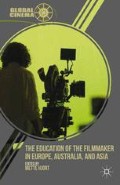Abstract
The aims of this chapter are to identify the main Lithuanian agents operating in the field of practice-oriented film education, and to analyze their position and positional shifts in the field of culture and art education in general from the perspective of recent history. I will regard the respective field as a “site of struggles” and “power,” as Pierre Bourdieu puts it, in which operating agents use different “activities and specific strategies”1 in order to transform or maintain traditional relations in a given area. In so doing, I hope to identify the key stages of practice-based film education in Lithuania and to reveal the importance of different forms of training or tutoring: those linked to a conservatoire-style model of the film school, and those driven by a search for alternatives and a commitment to “learning by doing.” I further argue that Lithuania is quite distinctive as a country when it comes to the “tolerance” it exhibits toward self-trained filmmakers and their ideas. There appears, I contend, to be a kind of intuitive appreciation of the sorts of “molecular” structures that Gilles Deleuze and Félix Guattari have identified in a quite different context,2 and of the ways in which such structures contribute to a vital kind of creativity that can be crucial for a given milieu.
Access this chapter
Tax calculation will be finalised at checkout
Purchases are for personal use only
Preview
Unable to display preview. Download preview PDF.
Notes
Pierre Bourdieu, “The Intellectual Field. A World Apart,” in Theory in Contemporary Art since 1985, ed. Zoya Kocur and Simon Leung (Oxford: Blackwell Publishing, 2005), 11–18.
Gilles Deleuze and Félix Guattari, A Thousand Plateaus. Capitalism and Schizophrenia (London: Continuum, 2010).
David A. Cook, A History of Narrative Film (New York and London: W.W. Norton & Company, Inc., 2004), 699.
Saulius Macaitis, “The Sixties,” in The World of Lithuanian Images. Litauische Bilderwelten, ed. Myriam Beger, Lolita Jablonskienė, Birutė˙ Pankūnaitė, and Rūta Pileckaitė. English translation by Artūras Tereškinas (Vilnius: Contemporary Art Information Centre of Lithuanian Art Museum, 2002), 8.
Graeme Turner, introduction to the chapter titled “Industries,” in The Film Cultures Reader, ed. Graeme Turner (London and New York: Routledge, 2002), 135.
Tom O’Regan, “A National Cinema,” in The Film Cultures Reader, ed. Graeme Turner (London and New York: Routledge, 2002), 139.
Julie MacLusky, introduction to Is There Life after Film School? In Depth Advice from Industry Insiders (New York and London: Continuum, 2003), xi.
Graeme Turner, Film as Social Practice (London and New York: Routledge, 2006), 182.
Audrone˙ Žukauskaitė, “Ethics between Particularity and Universality,” in Deleuze and Ethics, ed. Nathan Jun and Daniel W. Smith (Edinburgh: Edinburgh University Press, 2011), 196.
In Cinema: 2: Time-Image (1985), Gilles Deleuze develops the concept of “time-image.” He argues that a direct “time-image” (or pure representation of time) “clearly goes beyond the purely empirical succession of time—past-present-future,” as it is “a coexistence of distinct durations, or of levels of duration; a non-chronological order.” For Deleuze the “time-image” is open to change, inasmuch as it involves a set of temporal relationships from which a potentially variable present flows. The problems confronted and reflected on in “time-image” films are never fully resolved, for these films pose questions rather than trying to provide answers or solutions. This openness strengthens the sense of the flow of time and points to the future as open to change. This kind of filmmaking emphasizes thinking and was seen by Deleuze as being closely associated with the auteur cinema (especially from the 1940s–1970s). See, Gilles Deleuze, Cinema 2: Time-Image (London: Continuum, 2010), xii.
Geert Lovink, Dark Fiber: Tracking Critical Internet Culture (Cambridge: MIT Press, 2002), 249.
Editor information
Copyright information
© 2013 Mette Hjort
About this chapter
Cite this chapter
Šukaitytė, R. (2013). Practice-Based Film Education in Lithuania: Main Actors and Sites of Struggle. In: Hjort, M. (eds) The Education of the Filmmaker in Europe, Australia, and Asia. Global Cinema. Palgrave Macmillan, New York. https://doi.org/10.1057/9781137070388_2
Download citation
DOI: https://doi.org/10.1057/9781137070388_2
Publisher Name: Palgrave Macmillan, New York
Print ISBN: 978-1-349-34427-7
Online ISBN: 978-1-137-07038-8
eBook Packages: Palgrave Media & Culture CollectionLiterature, Cultural and Media Studies (R0)

